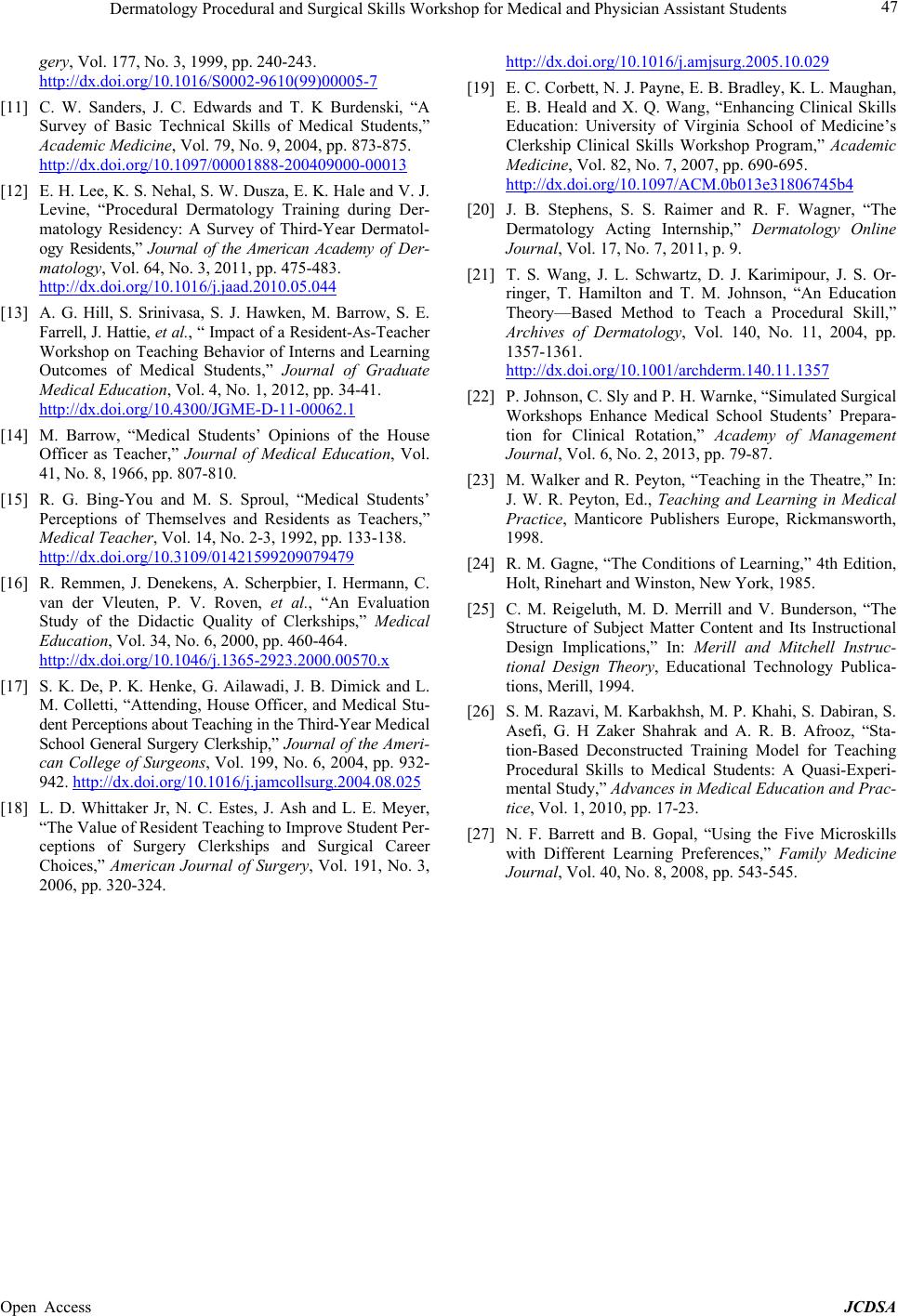
Dermatology Procedural and Surgical Skills Workshop for Medical and Physician Assistant Students
Open Access JCDSA
47
gery, Vol. 177, No. 3, 1999, pp. 240-243.
http://dx.doi.org/10.1016/S0002-9610(99)00005-7
[11] C. W. Sanders, J. C. Edwards and T. K Burdenski, “A
Survey of Basic Technical Skills of Medical Students,”
Academic Medicine, Vol. 79, No. 9, 2004, pp. 873-875.
http://dx.doi.org/10.1097/00001888-200409000-00013
[12] E. H. Lee, K. S. Nehal, S. W. Dusza, E. K. Hale and V. J.
Levine, “Procedural Dermatology Training during Der-
matology Residency: A Survey of Third-Year Dermatol-
ogy Residents,” Journal of the American Academy of Der-
matology, Vol. 64, No. 3, 2011, pp. 475-483.
http://dx.doi.org/10.1016/j.jaad.2010.05.044
[13] A. G. Hill, S. Srinivasa, S. J. Hawken, M. Barrow, S. E.
Farrell, J. Hattie, et al., “ Impact of a Resident-As-Teacher
Workshop on Teaching Behavior of Interns and Learning
Outcomes of Medical Students,” Journal of Graduate
Medical Education, Vol. 4, No. 1, 2012, pp. 34-41.
http://dx.doi.org/10.4300/JGME-D-11-00062.1
[14] M. Barrow, “Medical Students’ Opinions of the House
Officer as Teacher,” Journal of Medical Education, Vol.
41, No. 8, 1966, pp. 807-810.
[15] R. G. Bing-You and M. S. Sproul, “Medical Students’
Perceptions of Themselves and Residents as Teachers,”
Medical Teacher, Vol. 14, No. 2-3, 1992, pp. 133-138.
http://dx.doi.org/10.3109/01421599209079479
[16] R. Remmen, J. Denekens, A. Scherpbier, I. Hermann, C.
van der Vleuten, P. V. Roven, et al., “An Evaluation
Study of the Didactic Quality of Clerkships,” Medical
Education, Vol. 34, No. 6, 2000, pp. 460-464.
http://dx.doi.org/10.1046/j.1365-2923.2000.00570.x
[17] S. K. De, P. K. Henke, G. Ailawadi, J. B. Dimick and L.
M. Colletti, “Attending, House Officer, and Medical Stu-
dent Perceptions about Teaching in the Third-Year Medical
School General Surgery Clerkship,” Journal of the Ameri-
can College of Surgeons, Vol. 199, No. 6, 2004, pp. 932-
942. http://dx.doi.org/10.1016/j.jamcollsurg.2004.08.025
[18] L. D. Whittaker Jr, N. C. Estes, J. Ash and L. E. Meyer,
“The Value of Resident Teaching to Improve Student Per-
ceptions of Surgery Clerkships and Surgical Career
Choices,” American Journal of Surgery, Vol. 191, No. 3,
2006, pp. 320-324.
http://dx.doi.org/10.1016/j.amjsurg.2005.10.029
[19] E. C. Corbett, N. J. Payne, E. B. Bradley, K. L. Maughan,
E. B. Heald and X. Q. Wang, “Enhancing Clinical Skills
Education: University of Virginia School of Medicine’s
Clerkship Clinical Skills Workshop Program,” Academic
Medicine, Vol. 82, No. 7, 2007, pp. 690-695.
http://dx.doi.org/10.1097/ACM.0b013e31806745b4
[20] J. B. Stephens, S. S. Raimer and R. F. Wagner, “The
Dermatology Acting Internship,” Dermatology Online
Journal, Vol. 17, No. 7, 2011, p. 9.
[21] T. S. Wang, J. L. Schwartz, D. J. Karimipour, J. S. Or-
ringer, T. Hamilton and T. M. Johnson, “An Education
Theory—Based Method to Teach a Procedural Skill,”
Archives of Dermatology, Vol. 140, No. 11, 2004, pp.
1357-1361.
http://dx.doi.org/10.1001/archderm.140.11.1357
[22] P. Johnson, C. Sly and P. H. Warnke, “Simulated Surgical
Workshops Enhance Medical School Students’ Prepara-
tion for Clinical Rotation,” Academy of Management
Journal, Vol. 6, No. 2, 2013, pp. 79-87.
[23] M. Walker and R. Peyton, “Teaching in the Theatre,” In:
J. W. R. Peyton, Ed., Teaching and Learning in Medical
Practice, Manticore Publishers Europe, Rickmansworth,
1998.
[24] R. M. Gagne, “The Conditions of Learning,” 4th Edition,
Holt, Rinehart and Winston, New York, 1985.
[25] C. M. Reigeluth, M. D. Merrill and V. Bunderson, “The
Structure of Subject Matter Content and Its Instructional
Design Implications,” In: Merill and Mitchell Instruc-
tional Design Theory, Educational Technology Publica-
tions, Merill, 1994.
[26] S. M. Razavi, M. Karbakhsh, M. P. Khahi, S. Dabiran, S.
Asefi, G. H Zaker Shahrak and A. R. B. Afrooz, “Sta-
tion-Based Deconstructed Training Model for Teaching
Procedural Skills to Medical Students: A Quasi-Experi-
mental Study,” Advances in Medical Education and Prac-
tice, Vol. 1, 2010, pp. 17-23.
[27] N. F. Barrett and B. Gopal, “Using the Five Microskills
with Different Learning Preferences,” Family Medicine
Journal, Vol. 40, No. 8, 2008, pp. 543-545.